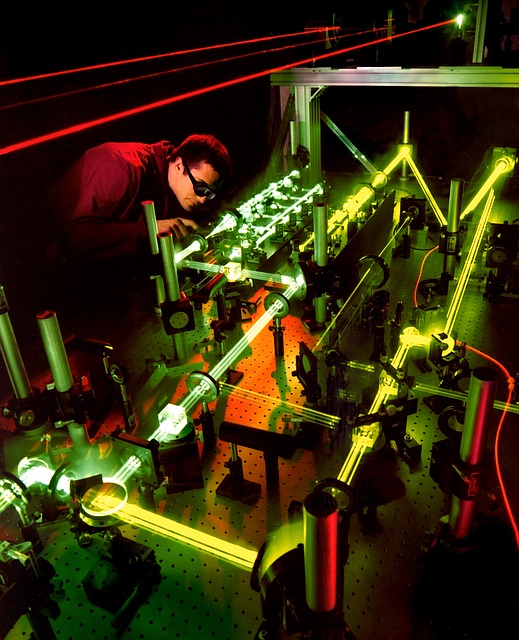3. Development Process and Components of Lasers
3-1. Development process of lasers
All lights are generated by atoms or molecules. An atom is composed of a nucleus surrounded by electrons. Electrons’ orbit around the nucleus various according to the type of the atom; the same type of atom has the same number of electrons of the same orbit. If an outermost electron is given a light energy from the outside or energy by collision with another electron or atom, the electron moves further to an outer orbit. This state where en electron moves further to the outermost orbit when the atom was given an additional energy is called an ‘excited state’ or ‘excited energy level’. Atoms in ground state have a longer lifetime without a time limit, but can maintain the excited state only for a limited time. As atoms are unstable in excited state, they tend to emit the received energy in the form of light energy and return to the original orbit where they maintain a stationary status. Atoms in stationary status are referred to as in ‘ground state’.That is, light is emitted when atoms or molecules return to the ground state or when the excited state with a higher energy returns to a state with a lower energy. The number of atoms that constitute materials is countless in effect.Since each atom absorbs energy and emits a light individually, the emitted lights have different phases and wavelengths. The process where electrons in the excited states emits photons while spontaneously turning to the ground state is called ‘spontaneous emission’. Light emission from bulbs, fluorescent lights and neon signs are all examples of spontaneous emission. These lights emitted by spontaneous emission are characterized by broad spectrum and incoherence between each other.
On the other hand, stimulated emission refers to the emission of photons in the course of transition from the excited state to the ground state induced by external incident photons. The photons generated by stimulated emission have the same frequency, phase and direction as the photons of the incident wave, presented as coherence. This process appears as if one incident light doubled, making two rays of light of identical nature. A laser is a device that amplifies light through the process of stimulated emission.
[Ad. ▶HELIOSⅡ/LOTUSⅡ/HYPERION – Manufacturer: LASEROPTEK(www.laseroptek.com)
In natural condition of thermal equilibrium, there are generally far more atoms in ground state than those in excited state, thus the probability of stimulated emission is only about 10-12 . In order to increase the probability of stimulated emission, the number of atoms in excited state has to be higher than those in ground state. Some atoms have a longer lifetime when it becomes excited by absorbing light energy than the time it takes to make transition to a lower energy level. This property can be found in a synthetic ruby, which is made by adding a little bit of chromium ions (Cr3+) to a sapphire, crystalline alumina. This gain medium becomes excited when exposed to strong light energy by a Xe or Kr lamp. At this point, the number of atoms in excited state is greater than those in ground state (or in lower energy level), and this state is called ‘population inversion’. If the condition of population inversion is satisfied, stimulated emission becomes amplified like an avalanche while the light passes through the gain medium. However, the amount of stimulated emission is still not enough to generate a laser and a resonator is required to meet the required amount. The resonator is consists of a total mirror, which has 100% reflectivity for laser wavelengths, and an output coupler, which lets some of them transmitted. By placing the gain medium between the two mirrors, the light generated by stimulated emission repeatedly travels between the mirrors reflecting back on itself, until some of the amplified light is emitted through the output coupler as laser light. To put it simply, the following three components are essential to generate laser:
1) A laser gain medium with an energy level that can induce population inversion.
2) A pumping source required for inducing population inversion.
3) An optical resonator for amplifying the light generated by stimulated emission.
4. Laser Types
Lasers can be categorized systematically into solid-state lasers, gas lasers, liquid lasers, semiconductor lasers, etc. The gain medium of a laser defines its wavelength. Characteristics of lasers by systematic categories are described below.
4-1. Solid-state lasers
Solid-state lasers use (amorphous) glass or crystalline ‘host’ material to which active atoms (molecules) are uniformly dispersed as the gain medium. The first laser light in human history produced by Maiman was also a solid-state laser using a synthetic ruby. Solid-state lasers typically use photon pumping method, for which a flashlamp, arc lamp, or laser diode is used.
Solid-state lasers can be subdivided into several types, chiefly such as ruby laser (emission at 694nm), Nd:Glass laser (1.05㎛), Nd:YAG laser (1.06㎛), and tunable laser. Giant pulse can be obtained by Q-switching. Nd:YAG laser, first produced in 1964, is a four-level laser, which is composed of ① ground state level, ② the lower laser level, ③ the upper laser level of metastable state, and ④ pump band level. Nd:YAG is a compound word from the initial letters of Yttrium, Aluminium and Garnet, with some addition of Neodymium (Nd). YAG is the basic material of neodymium, the atoms of which emits strong laser beams at 1.06㎛ (near infrared), and YAG crystals are also excited by strong light such a flash lamp. Among solid-state lasers, ruby laser, alexandrite laser, Nd:YAG laser, Nd:Glass laser, Er:Glass fiber laser, Ho:YAG laser and Er:YAG laser are currently used for medical purposes.

4-2. Gas lasers
Gas lasers use active atoms (molecules) of gas or mixed gas containing them as the gain medium. In gas lasers, excited state can be induced by discharge (plasma) or by electron beam. He-Ne laser (emission at 633nm), carbon dioxide laser (10.6㎛), Argon-ion laser (488nm, 514nm) are commonly used. There are also copper (Cu) vapor laser and excimer laser.
The He-Ne laser, first produced in 1962, is the first gas laser. Although the output power is weak, it can induce stable continuous wave (CW) for a long time, making it still commonly used in measuring.
The carbon dioxide laser, first produced in 1964, is a very powerful laser, with scores of kilowatts of CW output. The energy efficiency is as high as 15-20%, making it useful for laser processing.
The argon laser was first produced in 1964 and is capable of continuous output of about 1W. It commonly uses water cooling system but air cooling system can be used in some cases. It is characterized by the presence of several oscillations between green (514.5nm) and blue (488nm) lasers, contributing to the wide range of visible lasers.
The excimer laser is a high-output UV laser and mostly used for chemical reaction process or medical purposes. Excimer molecules include ArF (emission at 193nm), KrF (248nm) and XeCl (308nm), and the pulsed light has average 50-200W power output. However, the energy efficiency is generally poor at about 0.5-1%. In the excimer laser, atoms of fluorine and krypton, which do not combine in the ground state, becomes excited and combines as an excimer molecule, which is unstable and immediately returns to the ground state, during which the ultraviolet is emitted. This is the principle of the excimer laser. The term ‘excimer’ is short for ‘excited dimer’, which refers to the molecule that exists only in the excited state.
Among gas lasers, excimer laser, copper vapor laser, He-Ne laser and carbon dioxide laser are currently used for medical purposes.
4-3. Liquid lasers (dye lasers)
Liquid lasers use active molecules, such as a dye, diffused through a liquid, such as alcohol, as a lasing medium. Liquid lasers include organic and inorganic lasers and dye lasers; recently, liquid lasers mostly refer to dye lasers. Excitation is typically induced by light. Liquid lasers are easy for tuning wavelengths and the peak output power at 370-720nm reaches scores of kW. The efficiencies of ion laser and excited laser energy are 10-20%. Among liquid lasers, the dye laser at around 600nm is currently used for medical purposes.
4-4. Semiconductor lasers
The semiconductor laser was first demonstrated in 1962 but continuous wave operation succeeded first in 1970. Since then, it went through a series of improvement, and the development of double heterostructure and stripe structure has led to its wide application in fiber-optic communications, CD players, laser printers, laser scanners and laser pointers. It is now produced the most among lasing devices. The basic structure is P-N junction, although the laser diode is of double hetero-structure that has light-emitting layer (active layer) inserted between the cladding layers on both sides. The laser diode uses the cleaved facet as the total mirror (resonator). GaAs, GaAlAs orInGaAsP is used as the material. Laser diodes are highly efficient, small and lightweight, cheap, and have high energy efficiency of 20-40% for multiple-quantum-well structure and ~25% for P-N type. The continuous output covers from ultraviolet to visible lights, and the development of devices with the optical pulse output of 50W (100ns pulse width) has made it a very convenient laser oscillator for a laser radar and excitation light source.
Among semiconductor lasers, wavelengths at 405nm, 650nm, 810nm, 930nm and 980nm are widely used for medical purposes.
- To be continued -
▶ Previous Artlcle : #1. The birth of laser and its characteristics
▶ Next Artlcle : #3. Lasers and Soft Tissue Interaction Ⅰ





















